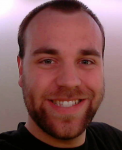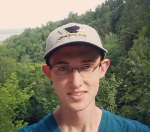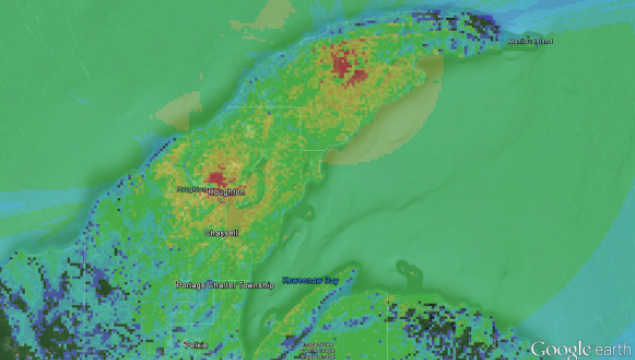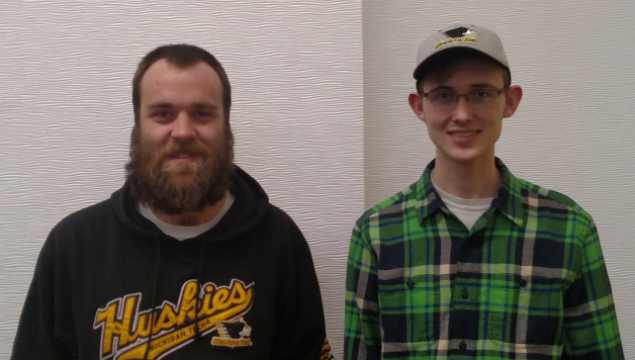Keweenaw Communications: Providing Supplemental Communications in Areas of Limited Cellular Coverage
Why This Project Is Important
Michigan’s Keweenaw peninsula is host to countless outdoor activities. Snowmobiling, hiking, camping, climbing, and skiing are just a few. These activities place people well outside of cell phone coverage. The terrain of the Keweenaw can be challenging and dangerous. As such, injuries happen and can be life threatening. An alternate system is needed to supplement cellular coverage and provide communications in remote areas.
Project Description
As part of the Computer Network and System Administration program at Michigan Technological University, students are required to complete a senior project. Generally, students work on one of several recurring department projects sponsored by various companies. In our case, a secondary option is available. Through the ITOxygen Student Enterprise at Michigan Tech we are able to define our own project and see it to fruition. We are seeking sponsorship for the construction of a communications site in the Keweenaw peninsula of Michigan.
The Need:
Michigan’s Keweenaw peninsula is host to countless outdoor activities. Snowmobiling, hiking, camping, climbing, and skiing are just a few. These activities place people well outside of cell phone coverage. The terrain of the Keweenaw can be challenging and dangerous. As such, injuries happen and can be life threatening. An alternate system is needed to supplement cellular coverage and provide communications in remote areas. Such a system is already partially in place. The Husky Amateur Radio Club (HARC) operates an all digital system that covers the Houghton-Hancock area and south to about Alberta, MI. Expansion is needed to cover farther north. We believe that one additional site will provide coverage to the majority of the Keweenaw.
Above, in the project photos, is a coverage simulation of the system after our proposed expansion. Red indicates areas of the strongest coverage right near the sites. Note that the more southern site is already in place and operational. Yellow indicates areas of very good coverage. Green indicates areas of good coverage. Any of the blues indicate poor coverage. We expect vehicle based radios to function up to the blue areas. As you can see, the peninsula will be almost entirely covered with excellent to fair coverage, meaning communication will be possible nearly everywhere in the peninsula.
The System:
Motorola’s MOTOTRBO uses a standardized protocol called Digital Mobile Radio (DMR). This protocol is all digital and provides two simultaneous talk channels and an almost limitless number of talkgroups. Talkgroups (TGs) are logical channels that control who hears who. Communication transmitted on talkgroup 2 will permit those monitoring the same group to hear each other. The radios or “subscriber units” are standard business class two way radios. Since the DMR protocol is an open standard, several manufacturers produce compatible radios. This means subscriber costs are low. A “site” consists of a radio tower, antenna, repeater, and associated equipment. The core of the site is the repeater. The repeater listens for DMR traffic and then retransmits what it hears. In this way, a small handheld radio can effectively communicate reliably for many miles. Additionally, IP Site Connect allows sites to be connected over standard networking equipment. With IP Site Connect, the existing site in Hancock can be connected to any site in the world and TGs shared between. For our purposes, the two Keweenaw sites will be linked with directional microwave radios. This combined with backup power at the sites means the system is not reliant on other infrastructure. In the event of a massive power outage or civil emergency, the sites will continue operating.
The Site:
We have identified a location that is well suited to be the next site north from Hancock. The Calumet Air Force Station (CAFS) is currently operated by Keweenaw County. This site is an extremely good location for radio transmission (it’s the top of Mt. Horace Greely). There are already several existing amateur radio repeaters at this location. However, none are MOTOTRBO and none have the capabilities of DMR (Two conversations at once, TGs, etc). We already have preliminary permission to locate hardware at CAFS. We will have power, an internet connection and easy access to roof mounted antennas. There is no radio tower at CAFS. The site is so geographically well suited, and therefore antennas can be mounted to the roof of the building. This is advantageous as typically contractors must be hired to climb towers and install antennas. Licensing As described, this expansion will be licensed under FCC part 97. The Husky Amateur Radio Club will apply its callsign to the site. This means that users are required to be part 97 licensed. That being said, anyone that is licensed and has a radio (owned or borrowed) can use the system. This model reduces long term costs versus commercially licensed systems.
Use Cases:
The overall goal of this project is to cover the Keweenaw is such a way that individuals can communicate from nearly anywhere. In most cases users will be able to access the system with handheld radios running on batteries. Talkgroups (TG) allow for control of the scope of communications. We plan to have a primary talkgroup that everyone on the system will have programmed. This would be a TG that everyone heard. On the other hand, say a group from the MTU Four Wheelers club was on a trail ride. They could use another TG among themselves without disturbing other system users all while having the benefits of the entire system coverage. If they needed to contact someone outside their group they could simply change their radio over to the primary TG and talk to everyone (or whichever TG they wanted). Additionally, a phone patch can be setup on the system. A phone patch allows system users to place phone calls over the radio. In an emergency situation the patch could be used to call emergency services. The Husky Amateur Radio Club has a long history providing communications for events in the area. HARC has assisted with the following: Copper Dog 150 Sled Dog Race, Lake Superior Performance Rally, The Great Bear Chase, and a variety of parades and smaller events in the area. All of these events could benefit from the proposed system. Event safety and coordination would increase due to a common system with greater coverage versus traditional single site analog systems.
Funding:
Keweenaw County (the operators of the CAFS) have graciously permitted equipment for similar public service uses to be located at their site without recurring costs. This means we will not have to fund electric and internet service. Our only real cost is the equipment itself and any maintenance. Among required equipment is the repeater, antenna, and associated hardware. We will additionally need some off the shelf networking equipment and hardware for the wireless link between sites. Our total expected cost for implementing the CAFS site is about $8,500.
Meet the Researchers

Kory Wegmeyer
4th year Computer Network and System Administration student at Michigan Technological University.


Russ Louks
Russ Louks joins the School of Business and Economics as a professor of practice of Management Information Systems and the Advisor for the ITOxygen Enterprise team. He is a Certified Information Systems Security Professional (CISSP) from the International Information Systems Security Certification Consortium. He has 29 years of experience in designing, developing and implementing computer systems in manufacturing companies, including 4 years of managing the Ford university sourcing office in Houghton. He has a very diverse background in computer technologies including experience with a variety of data collection technologies including 2D bar codes, RFID technologies, computer networking, serial communications, and handheld computing devices. He also has experience with more traditional computing architectures such as client / server applications, web based applications, and database applications. He has delivered computer systems to plants in Europe, South America, Asia, and Australia and has led multi-national development teams.
days left
funded
last
What Your Donation Can Help Us Do:
- Purchase necessary site equipment
$200+ (5/40)
Corporate Logo Placement
Recent Donors
Some donors may be hidden.














 Gifts to projects listed on SUPERIORIDEAS.ORG are received and processed by Michigan Tech Fund. Michigan Tech Fund is a tax-exempt organization under Section 501(c)(3) of the Internal Revenue Code acting on behalf of Michigan Technological University. It is the policy of Michigan Tech Fund that a portion of the gifts and/or income therefrom may be used to defray the costs of raising and administering the funds.
Gifts to projects listed on SUPERIORIDEAS.ORG are received and processed by Michigan Tech Fund. Michigan Tech Fund is a tax-exempt organization under Section 501(c)(3) of the Internal Revenue Code acting on behalf of Michigan Technological University. It is the policy of Michigan Tech Fund that a portion of the gifts and/or income therefrom may be used to defray the costs of raising and administering the funds.
Questions for the Researcher